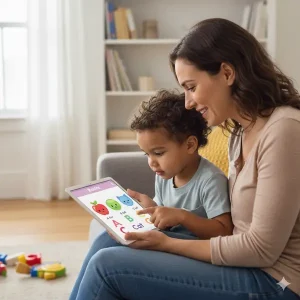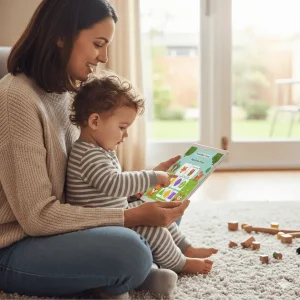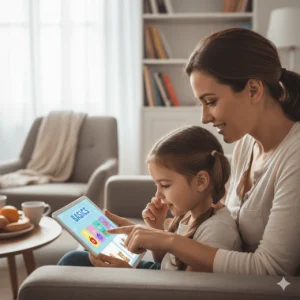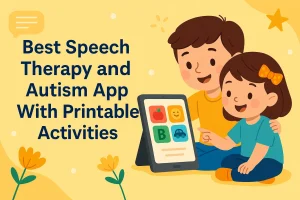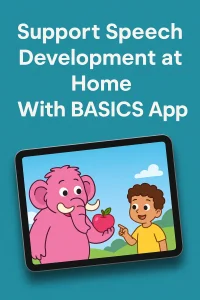How the BASICS App Supports Communication and Behavior in Autism
By Wellness Hub
Last Updated: October 14, 2025
Many parents of autistic children struggle to find ways to bridge the gap between what their child wants to say and what they can actually express. When communication is unclear or missing, frustration builds—often leading to meltdowns or behavioral challenges.
That’s where digital therapy tools like the BASICS App come in. Designed by therapists, BASICS empowers children with autism to develop speech, communication, and emotional understanding—right from home—through structured play and visual learning.
Understanding Communication Challenges in Autism
Communication challenges are among the most defining features of autism, but they look different for every child. Some children may speak in full sentences yet struggle to hold a conversation, while others may communicate primarily through gestures, sounds, or visual cues. Understanding why these challenges occur is the first step to supporting meaningful progress.
Why many autistic children struggle with speech, language, and social interaction
Children on the autism spectrum often experience differences in how their brains process sounds, words, and social cues. This can make it harder to link spoken language with meaning or to understand how conversations flow. Many children may find it difficult to:
- Recognize tone, emotion, or context in speech.
- Understand that communication is a two-way process — involving both speaking and listening.
- Maintain joint attention, which means focusing on an activity or object together with another person.
Because of these neurological differences, speech and language development in autistic children may not follow typical patterns. Some children start speaking later than expected, while others use language in repetitive or scripted ways. These variations don’t reflect a lack of intelligence or desire to connect — rather, they highlight how differently autistic minds learn and communicate.
Difference between verbal and nonverbal communication difficulties
Verbal communication difficulties involve challenges in producing and using spoken words effectively. A child might have limited vocabulary, unclear articulation, or difficulty forming sentences. They may also echo words or phrases (a pattern called echolalia) instead of generating new responses.
Nonverbal communication difficulties, on the other hand, affect how a child uses gestures, facial expressions, or eye contact to express themselves. For instance, a child might not point to request something, make less eye contact during interaction, or have limited use of facial expressions to show emotion.
Both types of challenges can overlap. A child who doesn’t speak much may still try to communicate through gestures or sounds, while a verbal child might speak fluently but struggle to interpret others’ expressions or emotions. Recognizing these distinctions helps parents and therapists choose the right support strategies — from speech modeling and imitation to visual communication aids or structured language practice.
Read More: How BASICS App Helps Kids Develop Speech and Language
How communication gaps can lead to frustration or behavioral outbursts
When a child wants to express something but lacks the tools to do so, frustration naturally follows. Communication breakdowns can lead to behaviors such as crying, shouting, aggression, or withdrawal — not out of defiance, but as an expression of unmet needs or emotional overload.
For example, a child who cannot say “I’m hungry” may cry or push food containers to signal their need. Similarly, when overwhelmed by too much sensory input or unclear instructions, a child may react with distress because they can’t verbalize what’s wrong.
By understanding the root cause — the communication gap — parents and caregivers can shift focus from managing behavior to building understanding. Structured visual supports, calm routines, and interactive tools like the BASICS App can help bridge these gaps by providing visual cues, repetition, and clear feedback. This not only reduces frustration but also empowers children to communicate with growing confidence and independence.
Introducing the BASICS App: A Therapist-Designed Autism Support Tool
The BASICS App was created by a team of certified speech, occupational, and behavioral therapists who understand the everyday challenges families face when supporting children with communication or behavior differences. Unlike many general learning apps, BASICS is built specifically for children with autism, speech delay, or ADHD, focusing on structured, step-by-step progress rather than open-ended play.
Where most autism apps focus on either speech or behavior alone, BASICS app brings both together in a single, therapist-guided experience. Each activity is thoughtfully sequenced so children can start at their own comfort level—whether that means recognizing simple objects or forming short sentences. The visual design minimizes distractions while keeping engagement high through clear visuals, consistent feedback, and gentle reinforcement.
Designed for children aged 2–8 years, the app covers the early developmental window when language and social skills are forming most rapidly. Parents can adjust pace and difficulty using Goal Mode and Library Mode, allowing personalized learning for both verbal and nonverbal children.
At the heart of BASICS App are three guiding principles:
- Structure: Every level follows a predictable learning path, reducing anxiety and helping children know what to expect next. This consistency supports better focus and emotional comfort.
- Repetition: Key words, sounds, and actions are practiced across multiple formats—visual, auditory, and interactive—to help children retain and generalize skills to daily life.
- Motivation Through Play: Learning happens through colorful visuals, animations, and positive reinforcement. Each success is celebrated, turning therapy-like practice into an enjoyable routine.
Together, these features make BASICS more than an app—it’s a structured digital therapy companion that empowers parents and engages children in meaningful communication practice every day.
How BASICS App Builds Communication Skills
From Nonverbal to Verbal — Early Language Foundation
Many children with autism begin their communication journey without spoken words. BASICS bridges this gap by focusing first on understanding and imitation, rather than forcing speech. The app introduces a gentle progression—from recognizing objects to naming them—using clear visuals and simple sounds.
Each activity pairs visual cues with auditory input, helping children connect what they see with what they hear. For example, when a child taps a picture of an apple, they hear the word “apple” spoken clearly. Over time, this pairing strengthens the brain’s link between sound and meaning, which is the foundation for speech.
Consistent repetition and feedback make these early interactions rewarding. When children hear correct pronunciations repeatedly and see positive animations after each response, they are naturally encouraged to imitate and vocalize. This process mirrors what therapists use in early speech sessions—turning imitation into communication through structured, playful practice.
Expanding Vocabulary and Sentence Formation
Once children begin to name familiar objects, BASICS helps them take the next step—using words meaningfully in context. Levels like Word Wonders and Phrase Park are designed to guide this transition.
In Word Wonders, children build their vocabulary through everyday items—animals, foods, toys, and actions—using video modeling and sound repetition. The visuals are intentionally realistic, helping kids link words to the world around them.
As vocabulary grows, Phrase Park introduces two- and three-word combinations such as “eat apple” or “throw ball.” These activities help children connect nouns and verbs naturally, without pressure. Gradually, they learn to form simple sentences like “The boy is running” or “The dog is sleeping.”
Through this structured approach, BASICS App nurtures both receptive language (understanding what is heard) and expressive language (using words to express thoughts). The balance of visual learning, auditory feedback, and playful repetition builds confidence and clarity in speaking.
Practicing WH Questions and Everyday Conversations
Understanding and responding to questions marks a major milestone in language development. In BASICS App, Inquiry Island helps children practice early WH questions—what, where, who, when, and why—through visuals and short scenarios.
For example, a child may see a picture of a girl eating and hear, “What is she doing?” They learn to choose or say “eating.” These small steps train both listening comprehension and verbal response. The questions are carefully sequenced, starting with simple “what” and “where” before moving to “why” and “how,” matching a child’s developmental readiness.
Beyond questions, Conversation Circles teach social communication skills—eye contact, turn-taking, and shared attention. Children practice real-life exchanges such as greetings, expressing feelings, or answering simple conversational prompts. The visual prompts keep them engaged, while structured choices help them respond confidently.
Together, these features create a safe space for children to practice real communication, not just isolated words. Over time, families often notice that these skills begin to appear naturally at home—during meals, play, or social moments—showing how digital learning can translate into everyday connection.
Supporting Positive Behavior Through Structured Learning
Children with autism often experience behavioral challenges that stem not from defiance but from communication difficulties and unpredictability in their environment. When kids can’t express what they feel, want, or need, frustration builds — leading to meltdowns, avoidance, or withdrawal. The BASICS App addresses these issues through a structured, predictable, and engaging learning system that combines speech, emotion, and behavior development.
By improving communication and building consistency through play, BASICS helps children transition from reactive behaviors to purposeful expression and self-regulation.
Reducing Frustration Through Expression
When communication improves, behavior often stabilizes
One of the strongest links in child development is between language growth and behavioral stability. The more a child can express needs, the less likely they are to rely on crying, shouting, or physical behaviors to communicate.
BASICS supports this process by using visual and auditory cues that make it easier for children to understand and respond. Activities focused on naming, requesting (“I want…”), and identifying familiar objects gradually build a sense of control.
As children learn to communicate, parents often observe reduced frustration and more cooperative behavior. Instead of guessing what their child wants, families start having small, meaningful exchanges — the building blocks of calm and connection.
BASICS App activities that replace tantrums with purposeful expression
Inside BASICS, structured activities like Word Wonders, Phrase Park, and Inquiry Island encourage children to practice using words and phrases in real-life contexts.
- “Word Wonders” teaches object naming — helping children replace pointing or crying with verbal requests.
- “Phrase Park” guides them to combine words naturally (“want ball,” “open door”).
- “Inquiry Island” introduces question-answering that boosts both comprehension and patience.
Each successful response reinforces positive communication, turning difficult moments into learning opportunities.
Emotional Regulation and Routine
Using Emotions Explorer to identify and express feelings
The Emotions Explorer feature helps children understand what emotions look and feel like. Through expressive faces, relatable stories, and sound prompts, children learn to identify feelings such as happy, sad, angry, or scared.
By naming emotions correctly, children gain emotional vocabulary — a vital tool for emotional regulation. For instance, being able to say “I’m angry” or “I’m tired” often prevents a meltdown before it happens.
Parents can guide these activities by discussing daily experiences (“How did you feel when we played outside?”). This bridges emotional learning in the app with real-world emotional awareness.
Goal Mode routines for predictability and reduced anxiety
Children with autism thrive on routine and clear expectations. BASICS’s Goal Mode offers a structured progression of activities, helping children know what to expect each session. Predictable order and visual progress bars make transitions smoother and reduce anxiety around change.
This structured repetition creates a safe learning rhythm — building comfort, confidence, and readiness for the next challenge. Over time, predictable practice helps children apply self-control skills not only during screen time but also in daily life routines like dressing, mealtime, or schoolwork.
Reinforcement and Motivation
Positive feedback loops and progress badges
Motivation plays a key role in sustaining learning and managing behavior. BASICS incorporates positive reinforcement through cheerful audio cues, animations, and visual badges after task completion.
These instant rewards tap into a child’s sense of accomplishment, reinforcing that calm, focused effort leads to positive outcomes. The system mirrors behavioral therapy principles, where consistent praise shapes desired behavior.
Encouraging persistence and task completion
Children are naturally motivated by visible progress. BASICS encourages persistence through short, achievable tasks that gradually increase in difficulty.
When a child completes a goal — matching, naming, or describing — they earn visual recognition, which promotes self-esteem and motivation to continue. Over time, this builds intrinsic motivation: the joy of learning for its own sake.
Parents can celebrate these small wins, helping children associate communication and calm behavior with success and appreciation, both within and beyond the app.
Parent-Led Practice at Home
Parent involvement is one of the strongest predictors of progress for children with autism. The BASICS App is designed to make this process simple, structured, and achievable at home—helping parents turn short, focused sessions into meaningful communication growth.
How Parents Can Guide Short Daily BASICS Sessions
Children with autism learn best through repetition and predictable routines. Even 10–15 minutes of guided play each day can create steady progress. Parents can sit beside the child, open a selected Goal Mode or Library Mode activity, and follow the audio-visual cues together.
Start with a calm setting and remove distractions. Let the child explore at their own pace—tapping, listening, and repeating words or sounds. Praise small efforts, such as an attempt to imitate a word, identify a picture, or answer a yes/no question.
Consistency matters more than duration. Short, enjoyable sessions are easier to maintain and help children associate the app with positive interaction, not pressure.
Building Consistency With Goal Mode Routines
Goal Mode in BASICS App helps parents create a daily rhythm. Each goal—like Early Learning Skills, Action Words, or Emotions Explorer—offers a sequence of tasks that automatically track progress. By completing one goal per day, children experience both structure and accomplishment.
Parents can set a predictable schedule—perhaps after breakfast or before bedtime—so the routine becomes part of the day. Over time, the child begins to anticipate these learning moments, improving focus and participation.
Routine not only strengthens learning but also reduces anxiety, providing the predictability that children on the spectrum often need to feel secure.
Pairing the App With Real-World Reinforcement (Daily Communication Cues)
What children practice in the app becomes powerful when linked to everyday life. If a child learns “apple” or “eat” in the app, parents can use those same words during mealtime. When the app teaches “happy” or “sad,” encourage the child to label emotions throughout the day.
Simple verbal prompts like “Show me your toy car” or “Point to your nose” connect digital learning to real-world understanding.
These small reinforcements help children generalize skills beyond the screen—strengthening expressive language, behavior regulation, and confidence in daily communication.
Why BASICS App is Trusted by Therapists and Parents
The BASICS App has earned the trust of both therapists and parents because it’s built on evidence-based methods, designed with real therapy principles, and tested through hands-on use with children across different abilities. Instead of overwhelming families with complex tools, BASICS simplifies speech, behavior, and learning support into short, structured, and rewarding sessions that fit naturally into daily life.
Parents see progress, therapists see consistency, and children enjoy the sense of play and accomplishment that comes with every completed goal.
Evidence-Informed Design Rooted in Speech and Behavioral Therapy
Every activity in BASICS is grounded in proven therapy approaches such as Applied Behavior Analysis (ABA) principles, speech-language therapy frameworks, and play-based learning. The app’s structure mirrors what therapists do in one-on-one sessions — focusing on imitation, repetition, and gradual skill building.
- Speech therapy alignment: Activities target articulation, vocabulary, and sentence formation using visual and auditory cues.
- Behavioral focus: Positive reinforcement motivates continued participation, while structured routines promote predictability and calm.
- Therapist collaboration: Each level — from Foundation Forest to Inquiry Island — was developed with direct input from speech and occupational therapists to ensure developmental accuracy.
This evidence-informed approach ensures that every tap, sound, and visual prompt contributes meaningfully to a child’s progress, making BASICS a reliable digital companion for therapy at home.
Adaptable for Different Levels — From Nonverbal to Verbal Communicators
BASICS is intentionally designed to meet children where they are. Whether your child is nonverbal, beginning to imitate sounds, or already forming short sentences, the app provides a clear, progressive pathway.
- Early communication: For nonverbal learners, activities start with picture-sound associations and imitation of everyday words.
- Emerging language: As children gain confidence, they move to labeling objects, answering yes/no questions, and identifying actions.
- Fluent speech: Advanced modules guide children toward WH questions, conversations, and sentence expansion.
Therapists appreciate this built-in adaptability because it mirrors natural developmental milestones, allowing them to personalize sessions or assign specific BASICS levels for home reinforcement. Parents value it for the same reason — children can learn at their own pace without pressure or confusion.
Offline Access for Families in Low-Connectivity Areas
Recognizing that consistent therapy support shouldn’t depend on a strong internet connection, BASICS offers offline access to core activities. Parents can download lessons in advance and continue daily practice anywhere — during travel, in rural regions, or at home without Wi-Fi.
Offline functionality ensures uninterrupted learning, helping children maintain routines and build communication consistency — two factors crucial for children with autism.
For therapists and families alike, this reliability reinforces BASICS as an inclusive, accessible, and dependable tool that adapts to every environment and need.
Integrating BASICS App With Other Therapies
How BASICS Complements ABA, Speech, and Occupational Therapy
The BASICS App is not meant to replace in-person or online therapy—it’s designed to work alongside it. Therapists often use BASICS to reinforce goals set during Applied Behavior Analysis (ABA), speech therapy, and occupational therapy sessions.
In ABA therapy, consistency and repetition are key. BASICS supports these principles by offering short, structured tasks that reward children for completing an activity or identifying a correct response. This promotes focus, motivation, and task compliance—all essential skills that align with ABA goals.
For speech therapy, BASICS provides a visual and auditory bridge. Children practice naming objects, following instructions, and forming phrases through levels like Word Wonders, Phrase Park, and Sentence Symphony. These structured exercises mirror therapist-led articulation and language sessions, helping children generalize what they learn in therapy to everyday life.
Occupational therapists also find BASICS useful for children who need help with attention, sequencing, and fine-motor coordination. The app’s tap-based interactions and visual categorization games (like matching, sorting, and sequencing) build focus, patience, and controlled responses—skills that directly support OT goals.
Using App Progress to Guide Therapist Sessions
One of the strengths of BASICS is its Goal Mode, which tracks a child’s progress across communication, behavior, and cognitive goals. Therapists can review these results to see which areas a child finds easy or challenging, and then personalize therapy accordingly.
For example, if a child consistently succeeds in naming objects but struggles with WH questions, the therapist can focus on comprehension-building activities during sessions. Similarly, consistent engagement with Emotions Explorer can help behavioral therapists identify which feelings a child recognizes easily and which need further support.
This data-driven approach allows therapy to become more responsive and efficient, ensuring each session builds on what the child is already practicing at home.
Parent Feedback Loop: Tracking Changes in Attention, Response, and Mood
Parents play a key role in this integration. BASICS encourages them to observe how their child’s attention, response time, and mood change over time. Short daily sessions—just 10 to 15 minutes—give parents valuable insights into when their child is most focused, what types of visuals engage them, and how they react to specific sounds or instructions.
By sharing these patterns with their child’s therapist, parents help create a collaborative feedback loop. Therapists can then adjust goals, reinforce strengths, or suggest new levels to target emerging needs. This consistent communication keeps therapy aligned between home and clinic, making progress smoother and measurable.
In this way, BASICS app acts as a bridge between home learning and professional therapy, helping children make steady, meaningful progress across environments.
About Wellness Hub
Wellness Hub is a trusted digital platform that empowers parents, caregivers, and professionals with science-backed tools for childhood development. From online speech therapy to home therapy resources, we offer a holistic ecosystem for children facing speech delays, autism, ADHD, and other developmental challenges.
Rooted in evidence-based practices and delivered by certified experts, Wellness Hub bridges the gap between accessibility and quality care. Whether you need at-home speech strategies, developmental checklists, or interactive mobile apps like BASICS, we make early intervention affordable and family-friendly.
Start your journey today with expert guidance tailored to your child’s unique communication and learning needs—anytime, anywhere.
Frequency Asked Question
1. What makes the BASICS App helpful for children with autism?
The BASICS App uses structured, therapist-designed activities that help children with autism build communication, attention, and behavior skills through play-based learning. Its visual and auditory supports make it easier for children to understand and express themselves.
2. Can the BASICS App be used by nonverbal children?
Yes. BASICS is designed for both verbal and nonverbal children. It starts with sound imitation and visual prompts, helping nonverbal kids gradually connect pictures, sounds, and words to begin communicating.
3. How does BASICS improve communication in autistic children?
BASICS strengthens both expressive and receptive language skills through interactive games. Activities like Word Wonders, Phrase Park, and Inquiry Island encourage naming, answering WH questions, and forming short sentences.
4. Does the BASICS App help with behavior management?
Yes. When children learn to express needs and feelings, behavioral frustration often decreases. BASICS also includes emotional learning activities like Emotions Explorer and predictable routines through Goal Mode that promote calm, consistent behavior.
5. Is the BASICS App a replacement for professional therapy?
No. BASICS is a home-based digital support tool that complements professional speech, occupational, or behavioral therapy. It reinforces skills between sessions and provides structured daily practice for parents and children.
6. How much time should a child spend using BASICS each day?
Parents can start with 10–15 minutes a day and gradually extend to 20–30 minutes. Consistency is more important than duration — short, focused sessions help reinforce skills effectively.
7. Does the BASICS App require internet access?
No. BASICS works both online and offline. Parents can download learning modules so children can continue practicing even without internet connectivity.
8. Can BASICS be personalized for my child’s developmental level?
Yes. BASICS features Goal Mode that adapts based on your child’s progress and Library Mode where parents can select specific goals such as communication, vocabulary, or emotional regulation.
9. How does the app help with emotional understanding and social skills?
The Emotions Explorer and Conversation Circles levels help children identify feelings, practice social interactions, and build empathy. These experiences encourage real-world emotional and social growth.
10. Is BASICS suitable for children with ADHD or mixed developmental delays?
Yes. While designed for autism support, BASICS also benefits children with ADHD or general speech delay by improving focus, attention span, and self-regulation through structured, gamified learning.
Book your Free Consultation Today
Parent/Caregiver Info:
Client’s Details:
* Error Message
